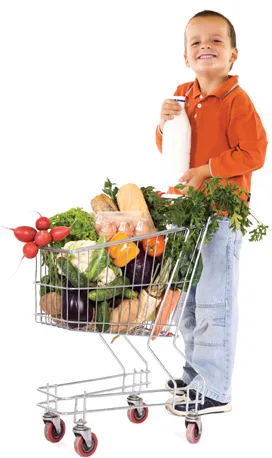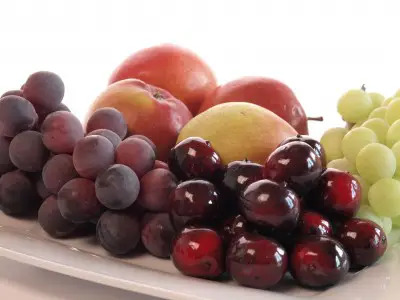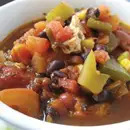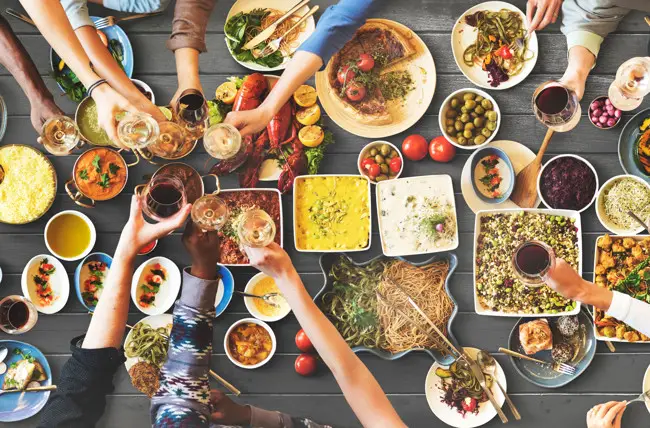Eating less meat can benefit your health, trim down your grocery bill, and help the environment. Learn about the many benefits of eating like a vegetarian once in a while and how to make sure your family gets the nutrition they need from meatless meals.
 The curtain opens. The show begins. First come the dancing hamburgers in billowing lettuce skirts and tomato bikinis. Next, the chicken. One after another the meats, the stars of the show, parade through the theater to raucous applause. In the wings, limp, dejected, and ignored, are the fruits, vegetables, and whole grains—each hoping that one day they’ll get their big break. This is the typical American “Broadway” plate, but it’s time for a new star.
The curtain opens. The show begins. First come the dancing hamburgers in billowing lettuce skirts and tomato bikinis. Next, the chicken. One after another the meats, the stars of the show, parade through the theater to raucous applause. In the wings, limp, dejected, and ignored, are the fruits, vegetables, and whole grains—each hoping that one day they’ll get their big break. This is the typical American “Broadway” plate, but it’s time for a new star.
Most Americans don’t eat enough fruits, veggies, and whole grains. This shortfall leaves us low in potassium, fiber, calcium, and vitamin D, which are important for both growing children and their parents. From building strong bones to keeping our bowels moving, these power foods are necessary for vitality, energy, good looks, and good health.
One sure-fire way to get your family eating more produce and whole grains is to include meatless meals in your diet. No, you don’t have to become vegetarians, but the occasional meal sans meat has many benefits, and they range from personal to global:
1. Health Benefits
Solid fats come from animal meat, and most contain saturated fat and trans fat, which raise “bad” LDL cholesterol. They can gunk up your arteries and lead to heart disease. Then there are liquid fats, or oils. Some oils like those found in nuts and avocados may help reduce LDL cholesterol levels when used in small portions and substituted for solid fat.
In addition to heart disease risk, there is convincing evidence that the more red and processed meat you consume, the higher your risk of getting colorectal cancer, says Marji McCullough, Sc.D., R.D., nutritional epidemiologist at the American Cancer Society. The ideal plate for cancer prevention, according to McCullough, has more plant food than meat. She recommends eating a variety of fruits and vegetables, from green broccoli to yellow peppers. Each color provides different health-boosting, cancer-fighting compounds called phytochemicals.
What is it about red and processed meats that increase the risk of colorectal cancer? According to McCullough, research is inconclusive. One theory suggests that the specific type of iron in red meat might jumpstart the formation of cancer-causing agents (carcinogens) in the gut. The preservatives in processed meats may also damage the intestine. The American Cancer Society recommends limiting intake of red and processed meat and avoiding frying or charbroiling, which can form carcinogens.
2. Your Finances
Meat tends to be one of the most expensive items in your grocery cart, while fiber-filled rolled oats and dried beans are two of the most cost-efficient foods. Off-season produce that was picked prematurely and shipped from afar can be costly, but frozen fruits and vegetables, which are flash-frozen at the height of freshness, may be less expensive and more nutritious.
Many people are dissuaded from cooking meatless meals because they’re worried fresh food will spoil before it’s used. Avoid this risk by preparing food as soon as you can. Rinse salad greens and stash them in damp paper towels in the crisper drawer. Plop fresh herbs into filled water glasses and refrigerate. To make dry staples user-friendly, batch-cook beans and grains on Sunday and add them to recipes throughout the week.
3. The Environment
According to the Food and Agriculture Organization of the United Nations, livestock manufacturing is responsible for more greenhouse gas emissions than transportation. It also accounts for more than 8 percent of global human water use, primarily to irrigate land that grows animal feed. When practical, buying meat directly from a farm near you is a good way to reduce your environmental impact and support local business while still enjoying meat.
Getting the Right Nutrition
When building your meal, divide your plate into three parts. Half of the plate is for fruits and vegetables, one quarter for whole grains, and one quarter for protein. Vegetarian sources of protein include peas, nuts, nut butters, and soy. Structure a meal around naturally low-fat sources of protein such as beans, lentils, and rice, and try to avoid flavoring food with lots of high-fat cheese.
Most Americans get more than enough protein to meet their needs, but if you start serving meatless dishes frequently, ensure your diet has enough protein, iron, calcium, zinc, and B12. These nutrients are readily available in a varied vegetarian diet.
Protein Needs by Age/Gender:
– Young children ages 1-3 need about 13g of protein per day
– Children ages 4-8 need 19g of protein per day
– Older kids (9-13) need 34g of protein per day
– Women older than 14 need 46g of protein per day
– Men older than 14 need 56g of protein per day
The more active you are, the more protein you need. Read food labels to track your protein intake compared to your goal. A healthy diet can include a variety of high-protein foods, including seafood, beans, meat, poultry, and eggs.
If your child is hesitant to dig into tofu cubes at dinner, never fear—meatless meals don’t have to be much different from your usual favorites. Vegetable pizza on a whole-wheat crust, black bean burritos, and vegetarian chili are all kid-friendly dinners that can satisfy your little carnivores and help them grow to be healthy and strong.
Caroline Kaufman, MS, RD, is a registered dietician, nutrition consultant, and freelance writer. For more of her expert advice, check out her blog, Sweet Foodie, and follow her on Facebook and Twitter.
Also See:
How to Decode Meat Lables (organic, free-range, cage-free, etc.)
Meatless Recipes to Try:
This quick vegetarian chili recipe replaces meat with lots of beans and vegetables and suggests using vegetarian burger crumbles to add texture and protein.
 Celery, Apple, and Grape Salad
Celery, Apple, and Grape Salad
This healthy, low-fat salad is easy to make and a great way for kids to get several servings of fruits and veggies.
This dish, which comes from a New York City chef, is best made after a trip to your local greenmarket or farmers market, when you have a lot of fresh veggies on hand.
This simple and fun dinner idea comes from a certified nutritionist and kids’ cooking instructor.











 The Best Vegetarian Chili
The Best Vegetarian Chili Greenmarket Vegetable Chowder
Greenmarket Vegetable Chowder Pumpkin Pie Pasta
Pumpkin Pie Pasta









